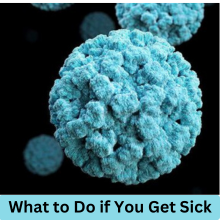
Norovirus outbreaks are a yearly concern, but this winter, they’re surging in parts of the United States. According to the latest data from the U.S. Centers for Disease Control and Prevention (CDC), the number of reported outbreaks has jumped significantly in recent weeks. This spike is alarming not only due to the discomfort the virus causes but also because of its potential to overwhelm public health systems during the colder months. With the winter season in full swing, it’s crucial to understand more about the virus, its symptoms, how it spreads, and what you can do to protect yourself and your loved ones.
What is Norovirus?
Norovirus is a highly contagious virus that causes stomach and intestinal inflammation, commonly referred to as “stomach flu.” However, it’s not related to the influenza virus, which primarily affects the respiratory system. Norovirus is the leading cause of foodborne illnesses in the United States, responsible for nearly 58% of food-related infections each year.
This virus spreads incredibly easily, requiring only a small number of viral particles (as few as 10) to cause an infection. With around 2,500 outbreaks reported annually, norovirus is responsible for millions of illnesses each year, though it is most common during the winter months, from November to April.
How Norovirus Spreads
Norovirus spreads quickly, especially in places where people are in close contact with each other. It is often transmitted through contaminated food or water, but it can also spread through direct contact with an infected person. For instance, sharing utensils, touching contaminated surfaces, or being in close quarters with someone who is sick (like on a cruise ship or in a nursing home) increases the chances of getting infected.
The virus can survive on surfaces for days, making thorough cleaning essential in preventing outbreaks, particularly in public spaces or facilities where people gather in large numbers.
Recent Surge in Norovirus Cases
Recent CDC data shows a concerning increase in norovirus outbreaks. For instance, during the week of December 5, 2024, 91 outbreaks were reported, up from 69 outbreaks the week before. This is a sharp increase compared to the previous years, where an average of 65 outbreaks were typically reported in early December. This uptick is indicative of a larger trend, potentially signaling a more widespread outbreak across various parts of the country.
Where Are These Outbreaks Occurring?
Norovirus outbreaks are being reported in various parts of the U.S., with certain regions seeing a higher incidence rate. Locations where people live in close quarters, such as nursing homes, hospitals, schools, and prisons, are particularly vulnerable. Cruise ships also see a higher frequency of outbreaks, where the virus can spread rapidly due to confined spaces and communal dining. The CDC monitors these regions closely, issuing warnings and recommendations to reduce the spread.
The Symptoms of Norovirus
Norovirus causes sudden onset of symptoms, which typically appear between 12 to 48 hours after exposure. The main symptoms include:
- Vomiting
- Diarrhea
- Nausea
- Stomach cramps
- Fever
- Body aches
These symptoms can be severe, particularly in vulnerable populations, but they generally resolve within one to three days. However, the virus’s rapid onset and severity often lead to dehydration, especially among children and the elderly.
How Long Does Norovirus Last?
Most people recover from norovirus within a few days. The illness generally lasts between 1 to 3 days, with vomiting and diarrhea being the most intense within the first 24 hours. While there is no specific medication to treat norovirus, staying hydrated is essential. For most, the worst is over within 48 hours, but in some cases, particularly for the elderly or those with compromised immune systems, the virus can have serious consequences.
Also read: Chris Hemsworth & Tom Holland’s 10-Year-Old Movie Hits Netflix Top Charts
Who is Most at Risk?
While anyone can contract norovirus, certain groups are more vulnerable to the effects of the virus. These include:
- Young children – Due to their smaller body size and greater likelihood of dehydration.
- Elderly individuals – They are more prone to severe complications, including dehydration.
- People with weakened immune systems – Those undergoing chemotherapy or living with chronic conditions are more susceptible to complications.
The Risk of Dehydration and Its Consequences
Dehydration is the most serious consequence of a norovirus infection. Vomiting and diarrhea can quickly lead to fluid loss, which may result in symptoms such as:
- Decreased urination
- Dry mouth
- Dizziness
- Unusual sleepiness (in children)
If dehydration becomes severe, it can lead to hospitalizations and even death, particularly among the elderly and young children. Therefore, it’s crucial to stay hydrated by drinking water, electrolyte solutions, or clear broths, especially during a bout of illness.
Preventing Norovirus Infections
Preventing the spread of norovirus is possible with some basic hygiene practices:
- Wash your hands – Soap and warm water for at least 20 seconds before eating or handling food.
- Disinfect surfaces – Clean kitchen counters, bathroom surfaces, and other commonly touched areas regularly, especially if someone in your household is sick.
- Avoid contaminated food – If you suspect that food has been contaminated, especially in communal settings, avoid consuming it.
By taking these simple steps, you can significantly reduce the likelihood of contracting the virus.
What to Do if You Get Sick
If you catch norovirus, the best course of action is to stay home and rest. Focus on staying hydrated to replace lost fluids and electrolytes. Avoid coffee, alcohol, and dairy products, as they can exacerbate dehydration.
Most cases resolve without the need for medical treatment, but if you experience severe symptoms, such as a high fever, prolonged vomiting, or signs of dehydration, seek medical help immediately.
Norovirus vs. Other Stomach Bugs
While norovirus shares some symptoms with other gastrointestinal illnesses, such as food poisoning and rotavirus, it is distinct in its contagiousness and the severity of its outbreaks. Unlike other stomach bugs, norovirus can spread quickly in confined spaces, which is why it causes frequent outbreaks in settings like schools, cruise ships, and nursing homes.
How the CDC Tracks and Responds to Outbreaks
The CDC plays a vital role in monitoring norovirus outbreaks. It tracks reported cases through the National Outbreak Reporting System (NORS) and issues guidelines to prevent further spread. When a surge in cases occurs, the CDC often provides updated guidance to local health authorities and the public to help curb the spread of the virus.
The Economic and Healthcare Impact of Norovirus
Norovirus has a significant economic impact on the U.S. healthcare system. It causes an estimated $2 billion in healthcare costs annually. The virus also results in nearly 900 deaths and 109,000 hospitalizations each year, putting a strain on emergency departments, especially during peak seasons.
How to Prepare for the Norovirus Season
With norovirus cases typically peaking in the winter months, it’s essential to prepare. Families should practice good hygiene, ensure access to hydration, and disinfect their homes regularly. Healthcare providers should also be ready for increased patient visits, especially from vulnerable populations.
Also read: Is Bitcoin’s $92K Drop the Beginning of a Bigger Crash?
Conclusion
The rise in norovirus cases this winter is a reminder of how easily the virus can spread, especially in crowded environments. Understanding its symptoms, transmission methods, and prevention strategies is key to protecting yourself and those around you. While norovirus outbreaks are concerning, simple measures such as frequent handwashing and surface cleaning can make a significant difference in controlling the spread. Stay informed and prepared, and stay healthy this winter!
FAQs
What is the best way to prevent norovirus infection?
The best way to prevent infection is by washing your hands frequently with soap and warm water, disinfecting surfaces regularly, and avoiding contaminated food or water.
How do I know if I have norovirus or something else?
If you experience sudden vomiting, diarrhea, nausea, and stomach cramps, it’s likely norovirus. Other illnesses, like food poisoning, might cause similar symptoms, but norovirus tends to be more sudden and severe.
Can norovirus be treated with medication?
There is no specific medication for norovirus. The best treatment is rest and rehydration, typically with water or electrolyte solutions.
Is norovirus dangerous?
While most people recover within a few days, norovirus can be dangerous for the elderly, young children, and those with weakened immune systems, especially due to the risk of dehydration.
How long does norovirus last?
Most people recover within 1 to 3 days. However, symptoms can be severe in the initial 24 hours before improving. If symptoms persist or worsen, seek medical advice.

